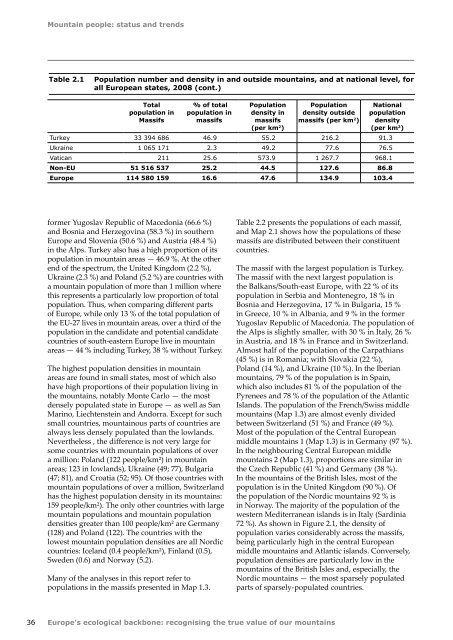Europes ecological backbone.pdf
Europes ecological backbone.pdf
Europes ecological backbone.pdf
Create successful ePaper yourself
Turn your PDF publications into a flip-book with our unique Google optimized e-Paper software.
Mountain people: status and trends<br />
Table 2.1<br />
Population number and density in and outside mountains, and at national level, for<br />
all European states, 2008 (cont.)<br />
Total<br />
population in<br />
Massifs<br />
% of total<br />
population in<br />
massifs<br />
Population<br />
density in<br />
massifs<br />
(per km 2 )<br />
Population<br />
density outside<br />
massifs (per km 2 )<br />
National<br />
population<br />
density<br />
(per km 2 )<br />
Turkey 33 394 686 46.9 55.2 216.2 91.3<br />
Ukraine 1 065 171 2.3 49.2 77.6 76.5<br />
Vatican 211 25.6 573.9 1 267.7 968.1<br />
Non‐EU 51 516 537 25.2 44.5 127.6 86.8<br />
Europe 114 580 159 16.6 47.6 134.9 103.4<br />
former Yugoslav Republic of Macedonia (66.6 %)<br />
and Bosnia and Herzegovina (58.3 %) in southern<br />
Europe and Slovenia (50.6 %) and Austria (48.4 %)<br />
in the Alps. Turkey also has a high proportion of its<br />
population in mountain areas — 46.9 %. At the other<br />
end of the spectrum, the United Kingdom (2.2 %),<br />
Ukraine (2.3 %) and Poland (5.2 %) are countries with<br />
a mountain population of more than 1 million where<br />
this represents a particularly low proportion of total<br />
population. Thus, when comparing different parts<br />
of Europe, while only 13 % of the total population of<br />
the EU‐27 lives in mountain areas, over a third of the<br />
population in the candidate and potential candidate<br />
countries of south-eastern Europe live in mountain<br />
areas — 44 % including Turkey, 38 % without Turkey.<br />
The highest population densities in mountain<br />
areas are found in small states, most of which also<br />
have high proportions of their population living in<br />
the mountains, notably Monte Carlo — the most<br />
densely populated state in Europe — as well as San<br />
Marino, Liechtenstein and Andorra. Except for such<br />
small countries, mountainous parts of countries are<br />
always less densely populated than the lowlands.<br />
Nevertheless , the difference is not very large for<br />
some countries with mountain populations of over<br />
a million: Poland (122 people/km²) in mountain<br />
areas; 123 in lowlands), Ukraine (49; 77), Bulgaria<br />
(47; 81), and Croatia (52; 95). Of those countries with<br />
mountain populations of over a million, Switzerland<br />
has the highest population density in its mountains:<br />
159 people/km²). The only other countries with large<br />
mountain populations and mountain population<br />
densities greater than 100 people/km² are Germany<br />
(128) and Poland (122). The countries with the<br />
lowest mountain population densities are all Nordic<br />
countries: Iceland (0.4 people/km²), Finland (0.5),<br />
Sweden (0.6) and Norway (5.2).<br />
Many of the analyses in this report refer to<br />
populations in the massifs presented in Map 1.3.<br />
Table 2.2 presents the populations of each massif,<br />
and Map 2.1 shows how the populations of these<br />
massifs are distributed between their constituent<br />
countries.<br />
The massif with the largest population is Turkey.<br />
The massif with the next largest population is<br />
the Balkans/South-east Europe, with 22 % of its<br />
population in Serbia and Montenegro, 18 % in<br />
Bosnia and Herzegovina, 17 % in Bulgaria, 15 %<br />
in Greece, 10 % in Albania, and 9 % in the former<br />
Yugoslav Republic of Macedonia. The population of<br />
the Alps is slightly smaller, with 30 % in Italy, 26 %<br />
in Austria, and 18 % in France and in Switzerland.<br />
Almost half of the population of the Carpathians<br />
(45 %) is in Romania; with Slovakia (22 %),<br />
Poland (14 %), and Ukraine (10 %). In the Iberian<br />
mountains, 79 % of the population is in Spain,<br />
which also includes 81 % of the population of the<br />
Pyrenees and 78 % of the population of the Atlantic<br />
Islands. The population of the French/Swiss middle<br />
mountains (Map 1.3) are almost evenly divided<br />
between Switzerland (51 %) and France (49 %).<br />
Most of the population of the Central European<br />
middle mountains 1 (Map 1.3) is in Germany (97 %).<br />
In the neighbouring Central European middle<br />
mountains 2 (Map 1.3), proportions are similar in<br />
the Czech Republic (41 %) and Germany (38 %).<br />
In the mountains of the British Isles, most of the<br />
population is in the United Kingdom (90 %). Of<br />
the population of the Nordic mountains 92 % is<br />
in Norway. The majority of the population of the<br />
western Mediterranean islands is in Italy (Sardinia<br />
72 %). As shown in Figure 2.1, the density of<br />
population varies considerably across the massifs,<br />
being particularly high in the central European<br />
middle mountains and Atlantic islands. Conversely,<br />
population densities are particularly low in the<br />
mountains of the British Isles and, especially, the<br />
Nordic mountains — the most sparsely populated<br />
parts of sparsely-populated countries.<br />
36 Europe's <strong>ecological</strong> <strong>backbone</strong>: recognising the true value of our mountains

















